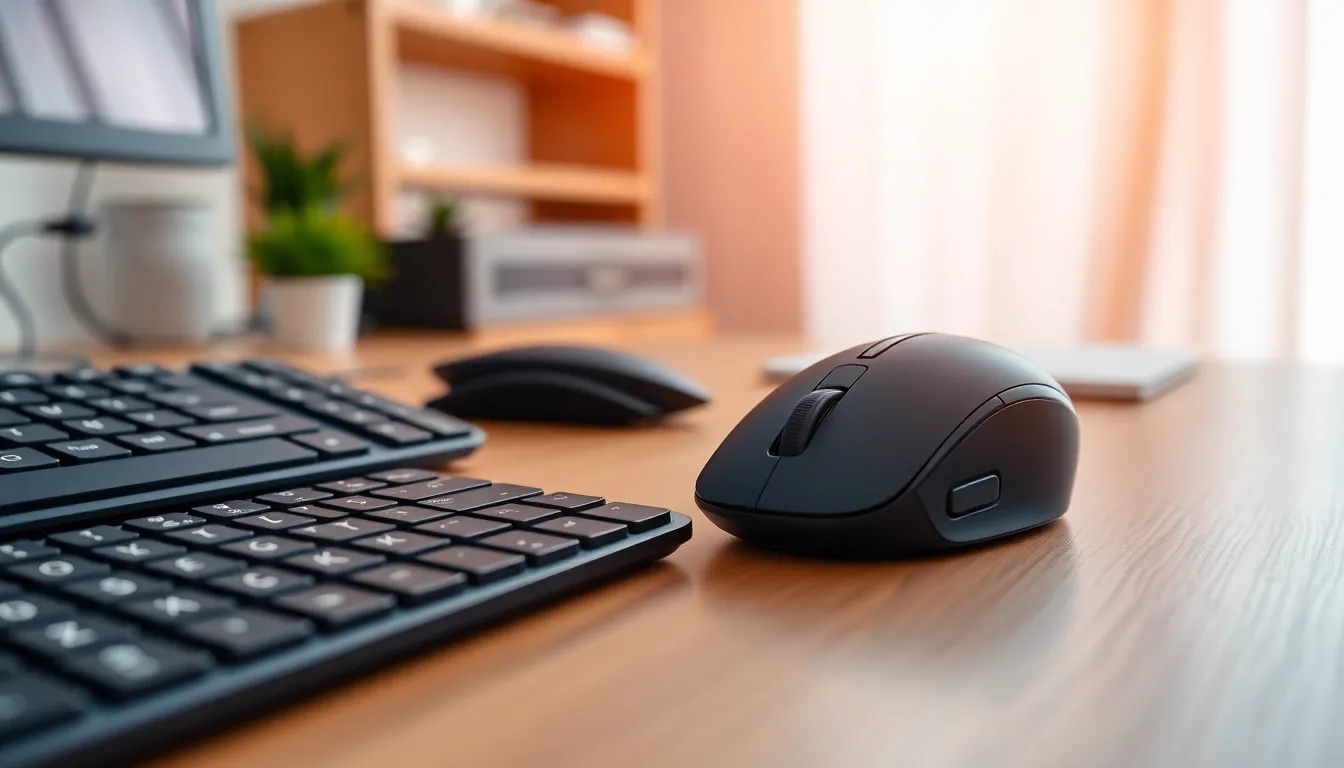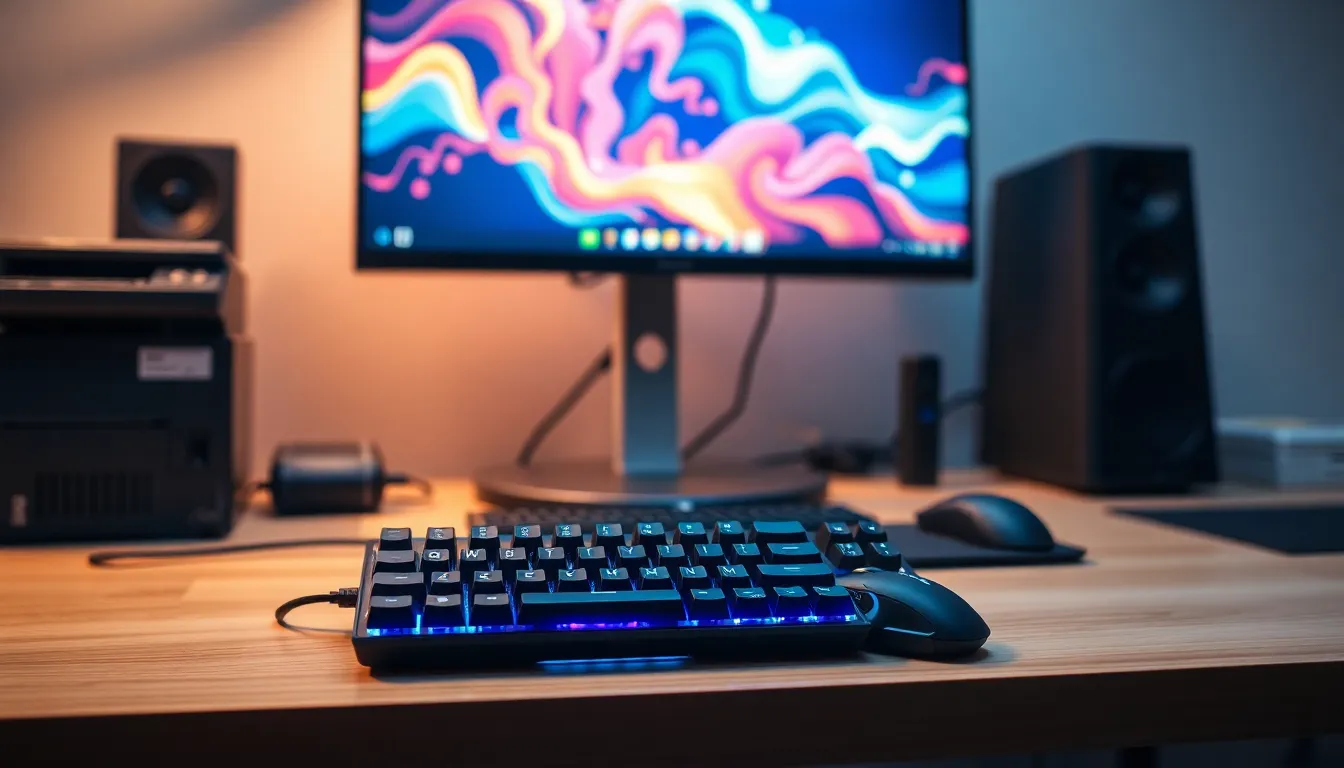In the world of computers, peripherals are the unsung heroes, quietly working behind the scenes to elevate the user experience. Think of them as the trusty sidekicks to your superhero machine, making every click and keystroke feel like magic. From mice that glide smoother than a greased weasel to keyboards that respond faster than a caffeinated squirrel, these gadgets can make or break your digital adventures.
Table of Contents
ToggleOverview of Computer Peripherals
Computer peripherals refer to external devices that connect to a computer, enhancing its functionality. These tools play a critical role in user interaction and productivity. Common examples include keyboards, mice, printers, and monitors. Each device serves a distinct purpose and can significantly affect performance.
Keyboards facilitate data input, enabling users to type efficiently. Mice offer precise control for navigating interfaces, making tasks easier and more intuitive. Printers allow users to produce hard copies of digital documents, essential for physical records. Monitors display visual information, impacting overall computing experience through clarity and resolution.
In addition, sound devices like speakers and headphones enable auditory feedback, enriching multimedia experiences. External storage devices, such as USB drives and external hard drives, provide expanded data storage options. Networking devices like routers connect computers to the internet, ensuring seamless communication and access to resources.
Innovations continue to improve these peripherals, leading to more ergonomic designs and enhanced features. Technological advances may integrate touch screens, artificial intelligence, and wireless connectivity into new devices. As a result, both professionals and casual users benefit from a diverse range of peripherals designed to meet specific needs.
Understanding the various types of computer peripherals allows users to make informed choices, optimizing their setups for better performance. Adapting these tools can significantly elevate the overall computing experience, making everyday tasks more efficient and enjoyable.
Input Devices

Input devices serve as crucial tools for interaction with computers. Their effectiveness directly enhances user engagement and productivity.
Keyboards
Keyboards represent a primary input device, enabling efficient data entry. They come in various designs like mechanical, membrane, and ergonomic, catering to different preferences. Mechanical keyboards offer tactile feedback, which many users prefer for typing accuracy. Membrane keyboards provide a quieter alternative for office environments. Ergonomic keyboards aim to reduce strain during extended use. Features like programmable keys enhance customization, allowing users to streamline their workflows.
Mice
Mice facilitate precise navigation within computer interfaces. Different types, including optical and laser mice, improve tracking accuracy based on various surfaces. Wireless mice offer freedom of movement, reducing desktop cable clutter. Additionally, gaming mice include customizable buttons and adjustable sensitivity, addressing the specific needs of gamers. The choice of a mouse can significantly impact gaming performance and general computing tasks.
Scanners
Scanners digitize documents and images, converting physical items into electronic formats. Types like flatbed, sheet-fed, and portable scanners address various requirements. Flatbed scanners provide high-quality image capture for photographs and large documents. In contrast, sheet-fed scanners efficiently handle multiple pages, making them ideal for office use. Portable scanners offer convenience for on-the-go scanning needs. Scanning capabilities play a vital role in document management and digital archiving.
Output Devices
Output devices play a crucial role in delivering information from a computer to the user, enhancing the overall computing experience.
Monitors
Monitors display visual information, providing an interface for users to interact with their systems. Numerous types exist, including LED, LCD, and OLED monitors, each offering unique benefits. LED monitors, often more energy-efficient, deliver vibrant colors and high contrast. LCD monitors are popular for their affordability and clarity, making them suitable for everyday use. OLED monitors provide superior image quality, featuring deeper blacks and better color accuracy, ideal for graphic designers and gamers. Users benefit from various screen sizes, allowing for customized setups tailored to their workspace.
Printers
Printers serve the essential function of producing physical copies of digital documents. Multiple printer types exist, including inkjet, laser, and thermal printers, each designed for specific needs. Inkjet printers excel at high-quality color prints, making them suitable for photography and design work. Laser printers, in contrast, are known for rapid printing speeds and lower cost per page, ideal for office environments. Thermal printers primarily produce labels and receipts, widely used in retail settings. Professionals and home users alike appreciate the range of features, including wireless connectivity and double-sided printing, enhancing efficiency across various tasks.
Storage Devices
Storage devices play a critical role in data management, offering solutions for saving and transferring information efficiently. Two prominent types are external hard drives and USB flash drives, each catering to different storage needs.
External Hard Drives
External hard drives provide substantial storage capacity, often ranging from 500 GB to 10 TB. These devices connect through USB or Thunderbolt, allowing quick access to large file collections. Users appreciate the backup capabilities that external hard drives offer, promoting data security in case of primary hard drive failures. Brands like Western Digital and Seagate lead the market, delivering reliable options with varying features such as encryption and automatic backup.
USB Flash Drives
USB flash drives offer portability and convenience, typically available in capacities between 2 GB and 2 TB. Their compact size makes transferring files between devices seamless. Many users favor these drives for their plug-and-play functionality, quickly uploading data without needing additional software. They accommodate diverse use cases, from storing essential documents to transferring photos and videos. Options from SanDisk and Kingston provide durable solutions with fast read and write speeds, appealing to both casual and professional users.
Computer peripherals are vital components that significantly enhance the user experience. By understanding the various types of input and output devices available users can tailor their setups to meet specific needs and improve productivity. The ongoing advancements in technology continue to introduce innovative features that make these peripherals more efficient and user-friendly.
From the precision of a gaming mouse to the clarity of a high-resolution monitor each device plays a unique role in the computing ecosystem. Investing in the right peripherals not only optimizes performance but also elevates everyday tasks into more enjoyable experiences. As technology evolves staying informed about the latest developments in computer peripherals will empower users to make the best choices for their digital environments.





